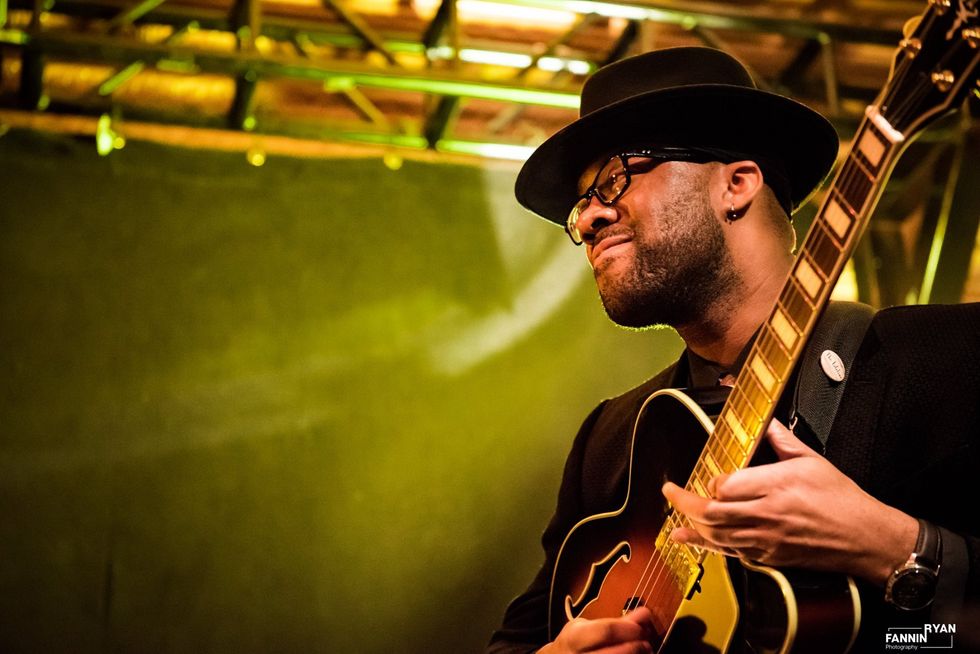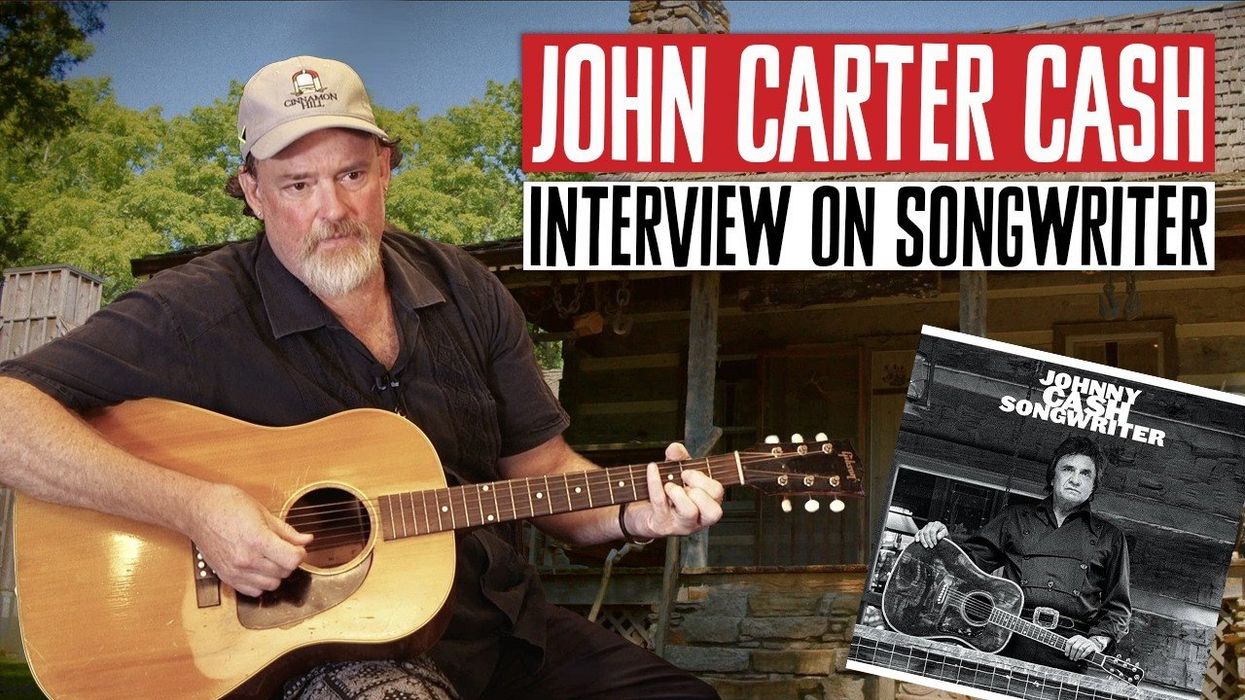
Intermediate
Intermediate
•Provide more structure to your lead lines.
•Give your solos a sense of movement with approach notes.
•Learn how to apply scales and arpeggios for a more intentional sound.
Do you feel like your solos lack focus or that there isn’t any underlying structure to your lines? Does it seem that you are wandering around the neck, hoping that what you are playing “looks like it sounds cool”? Would pushing peas around a dinner plate with a knife be more riveting than the last lick you played? If any of these statements are true, then you need some guide tones, my friend.
Guide tones, also known as target notes, are commonly used in jazz improvisation and usually refer to only the 3rd and 7th of a chord. But, for our purposes, we’re going to apply a more generous definition where all notes of a chord can be used. There are two benefits to using guide tones: They create a predetermined melodic structure that serves as a framework for your solo, and they provide an inner melody to your lines that carry the sound of the chord changes.
The first two examples show a couple of possibilities when building a guide tone melody over a ii-V-I chord progression in the key of C major. The only requirement is that the guide tones should be played on the strong beats of the measure (beats 1 and 3). Next, spell each chord to see what notes you have to work with. For our progression, our choices will come from Dm7 (D-F-A-C), G7 (G-B-D-F), and Cmaj7 (C-E-G-B). Since these examples have one chord per measure, I have chosen to use only one guide tone in each measure. But, I could have used two guide tones in a measure, one on beat 1 and the other on the beat 3. Other than what has already been discussed, there is no right or wrong way to do this. Basically, pick some chord tones, put them on the strong beat(s), and see how it sounds. Change or edit as you see fit!
Take a listen to Ex. 1. The guide tones create a descending melody that leaps up at the end. Using one note per measure, the line starts with C (the 7th of Dm7), then to B (the 3rd of G7), to G (the 5th of Cmaj7) and finally E (the 3rd of Cmaj7). Ex. 2 has a guide tone line similar to the first example, descending for the first three measures and a leap up at the end. It begins with F (the 3rd of Dm7), to D (the 5th of G7), to B (the 7th of Cmaj7), and then to E (the 7th of Cmaj7).
Ex. 3 is an eight measure progression, similar in structure to a popular jazz standard. Harmonically, the first half is a ii-V-I-IV in C major and the second half is a ii-V-i in the key of A minor. In the first six bars, there is one guide tone per measure, and then concludes with two guide tones in each of the last two bars.
Once you have decided on a framework for your solo, use scales and arpeggios to add notes before each guide tone. By doing so, you create motion in your line that sounds musical, and not like you’re choosing notes at random. Listen to Ex. 4 where each guide tone is approached from above by a scale step. Since all the chords are in the key of C, my approach notes are from the C major scale. I can also think in modal terms, where I would use D Dorian in bar 1 to approach the G7 in bar 2. Then, I can use G Mixolydian in bar 2 to approach the Cmaj7 in bar 3, and C Ionian to approach the next Cmaj7 in bar 4. Ex. 5 is the same scalar concept, this time approaching the guide tones from below.
Ex. 6 and Ex. 7 use arpeggios to approach the guide tones from above and below, respectively. I prefer to do this by using the arpeggio of the chord I am going to, not the one I am playing over. So, when I am playing over the Dm7 in the first measure, I will use the G7 arpeggio to approach the guide tone in bar 2. Then, when playing over G7 in the second measure, use the Cmaj7 arpeggio to approach the guide tone in bar 3. This concept is a little easier to see in Ex.7. Dm7 is the chord in bar 1. You approach the guide tone in bar 2 with a G, which is not in a Dm7 chord, but it is in G7.
To get longer lines, use two, three, or more notes from the scale or arpeggio when approaching the guide tones. Ex. 8 approaches the guide tone from above and below, using two and three notes from the scale. Ex. 9 shows the same approach methods, but with notes from the arpeggio.
After you get a handle on the guide tone concepts, experiment with rhythms, rests, and an ever-increasing number of approach notes. Check out Ex. 10 as an example of what is possible. It’s the guide tone line from Ex. 2 fleshed out with a mixture of scale and arpeggio approach notes of various lengths. Ex. 11 is an expansion of the guide tone line from Ex. 3. I used an increasing number of approach notes in the first half of the line. The second half is more rhythmically complex, ending with the triplet figures in the last two measures.
Applying these concepts to something more familiar, Ex. 12 is one possible guide tone melody over an A minor blues. Give it a listen to hear how the first two phrases are relatively scalar, but the last phrase has more of a “sawtooth” vibe. Ex. 13 is the completed solo, using the ideas discussed previously. Throwing everything into the guide-tone blender yielded different types of approaches combined with a variety of rhythms and rests.
Once you get a foothold, substitute different modes, scales, arpeggios, chords, and time signatures to achieve some different sonic flavors. Remember that you are restricting yourself to these few concepts in order to get a more melodic and meaningful solo. If you practice it enough, your brain will start working this way on its own!
The Man in Black returns with the unreleased Songwriter album. John Carter Cash tells us the story.
“The Man Comes Around” is a much-played song from the final album Johnny Cash recorded before his death in 2003, American IV: The Man Comes Around. Now, the Man in Black himself has come around again, as the voice and soul of an album he initially cut in 1993, titled Songwriter. It hits the street on June 28.
For fans who know Cash only through his much-loved American Recordings series, this is a very different artist—healthy, vital, his signature baritone booming, his acoustic playing lively, percussive, and focused. This is the muscular Johnny Cash heard on his career-defining recordings, from his early Sun Records sides like “Cry! Cry! Cry!” and “Folsom Prison Blues” to “Ring of Fire” and “Sunday Mornin’ Comin’ Down” to later, less familiar hits like “The Baron” and “That Old Wheel.” In short, classic Cash—the performer who became an international icon and remains one even 21 years after his death.
I recently visited the Cash Cabin recording studio—a log cabin on the Cash family property in Hendersonville, Tennessee, that was originally built as a sanctuary where Johnny wrote songs and poetry—with PG’s video team of Chris Kies and Perry Bean to talk about Songwriter with John Carter Cash, the son of Johnny and June Carter Cash.
In addition to getting the lowdown on Songwriter from John Carter Cash, he showed us some of the iconic guitars—including original Johnny Cash lead guitarist Luther Perkin’s 1953 Fender Esquire and a Martin that was favored by the Man himself—that dwell at the busy private studio. Check out this visit.
Guest picker Mei Semones joins reader Jin J X and PGstaff in delving into the backgrounds behind their picking styles.
Question: What picking style have you devoted yourself to the most, and why does it work for you?
Guest Picker - Mei Semones

Mei’s latest album, Kabutomushi.
A: The picking style I’ve practiced the most is alternate picking, but the picking style I usually end up using is economy picking. Alternate feels like a dependable way to achieve evenness when practicing scales and arpeggios, but when really playing, it doesn’t make sense to articulate every note in that way, and obviously it’s not always the fastest.
Obsession: My current music-related obsession is my guitar, my PRS McCarty 594 Hollowbody II. I think it will always be an obsession for me. It’s so comfortable and light, has a lovely, warm, dynamic tone, and helps me play faster and cleaner. This guitar feels like my best friend and soulmate.
Reader of the Month - Jin J X

Photo by Ryan Fannin
A: For decades, the Eric Johnson-style “hybrid picking” with a Jazz III for “pianistic” voicings. Great for electric, though not so much acoustic. I’ve been recently learning to use a flatpick, à la Brian Sutton, by driving the pick “into” the string at an angle—which makes me think of Pat Metheny and George Benson, without irony.
Obsession: I’m still focused on understanding the concepts of jazz, neo-classical, and beyond, though I’m also becoming obsessed with George Van Eps’ 7-string playing, flatpicking, hip-hop beats, the Hybrid Guitars Universal 6 guitar, and the secret life of the banjo.
Editorial Director - Ted Drozdowski

A: Decades ago, under the sway of Mississippi blues artists R.L. Burnside, Junior Kimbrough, and Jessie Mae Hemphill, I switched from plectrum to fingerstyle, developing my own non-traditional approach. It’s technically wrong, but watching R.L., in particular, freestyle, I learned there is no such thing as wrong if it works.
Obsession: Busting out of my songwriting patterns. With my band Coyote Motel, and earlier groups, I’ve always encouraged my talented bandmates to play what they want in context, but brought in complete, mapped-out songs. Now, I’m bringing in sketches and we’re jamming and hammering out the arrangements and melodies together. It takes more time, but feels rewarding and fun, and is opening new territory for me.
Managing Editor - Kate Koenig

A: I have always been drawn to fingerpicking on acoustic guitar, starting with classical music and prog-rock pieces (“Mood for a Day” by Steve Howe), and moving on to ’70s baroque-folk styles, basic Travis picking, and songs like “Back to the Old House” by the Smiths. I love the intricacy of those styles, and the challenge of learning to play different rhythms across different fingers at the same time. This is definitely influenced by my classical training on piano, which came before guitar.
Obsession: Writing and producing my fifth and sixth albums. My fifth album, Creature Comforts, was recorded over the past couple months, and features a bunch of songs I wrote in 2022 that I had previously sworn to never record or release. Turns out, upon revisiting, they’re not half bad! While that one’s being wrapped, I’m trying to get music written for my sixth, for which I already have four songs done. And yes, this is a flex. 💪😎
Guitarist, songwriter and bandleader Grace Bowers will independently release her highly anticipated debut album, Wine On Venus, August 9.
The new album adds to a breakout year for Bowers, who was recently selected as a U.S. Global Music Ambassador as part of the U.S Department of State and YouTube’s Global Music Diplomacy Initiative, is nominated for Instrumentalist of the Year at the 2024 Americana Music Association Honors & Awards and will make her debut performance on the legendary Grand Ole Opry on her eighteenth birthday, July 30, 2024. Other performances this year include shows supporting Slash, The Red Clay Strays and Brothers Osborne as well as stops at Levitate Music & Arts Festival, Floyd Fest, Bristol Rhythm & Roots Reunion, Bourbon & Beyond, XPoNential Music Festival and Pilgrimage Music & Cultural Festival. See below for complete tour itinerary.
Grace Bowers & The Hodge Podge - Tell Me Why U Do That (Official Video)
Produced by John Osborne (Brothers Osborne), Wine On Venus captures the electric energy of Bowers’ live performances with The Hodge Podge. The record consists of nine soul-infused tracks including a new version of Sly and the Family Stone’s “Dance to the Music” as well as previously release single, “Tell Me Why U Do That,” of which Forbes praises, “an infectious, joyous party and a worthy introduction to Bowers.” Additionally, The Bluegrass Situation declares, “an exceptional breakout talent who seems primed for a long career to come,” while RIFF Magazine calls her “The next generation’s star of American rock, blues and funk guitar.”
Of the record, Bowers shares, “I’m so excited to share my first album with the world in August! It’s been a long time coming, and I’m proud of what was created with the incredible Hodge Podge and John Osborne producing. We recorded everything live, as it should be, for this sonic journey. I hope you love it as much as I do.”
Additionally, of the title track, she reflects, “My nana was 100 years old when she passed away last year. She would always tell me that when she died, she would be drinking wine on Venus. She was a little eccentric but thought that was just something so cool. When she passed, I wrote a song about it.”
In addition to Bowers (guitar), the record features Joshua Blaylock (keys), Brandon Combs (drums), Eric Fortaleza (bass), Esther Okai-Tetteh (vocals) and Prince Parker (guitar) as well as songwriting collaborations with respected artists such as Ben Chapman, Meg McRee, Maggie Rose and Lucie Silvas.
Originally from the Bay Area and now calling Nashville home, Bowers began garnering attention after sharing videos of herself playing guitar on social media during the pandemic. In the years since, she’s been featured on “CBS Mornings” in a piece focused on a new wave of young female guitarists, performed alongside Dolly Parton as part of her Pet Gala special on CBS, joined Lainey Wilson as part of CBS’ New Year’s Eve Live celebration, performed as part of the “Men’s Final Four Tip-Off Tailgate Presented by Nissan” and been sought after by everyone from Devon Allman to Tyler Childers and Susan Tedeshi to Kingfish. Of her 2023 Newport Folk Festival debut, Rolling Stone declared, “Her 20-minute performance gave the distinct sense that everyone lucky enough to have attended was witnessing a star in the making,” while The Tennessean calls her “a 17 year old Blues guitar prodigy,” with a, “heart as big as her talent is vast.”
Most recently this summer, Bowers performed alongside Billy Idol at the Fired Up For Summer benefit concert and raised $30,000 for MusiCares and Voices for a Safer Tennesseewith her 2nd Annual “Grace Bowers & Friends: An Evening Supporting Love, Life & Music” benefit show. With the release of Wine On Venus (distributed by The Orchard), Bowers will further establish herself as one of music’s most intriguing new artists.
For more information, please visit gracebowers.com.
The new destination on Reverb will feature an always-changing collection of new and like-new music gear from top brands for at least 20% off retail prices.
“Outlet music gear is a fantastic value for music makers. Often, it’s brand new overstock or clearance music gear that retailers or brands are simply looking to clear out. Other times, it’s gear that’s been opened, used for a demo, or simply doesn’t have its original box, but is otherwise in like-new condition,” said Jim Tuerk, Reverb’s Director of Business Development. “With the launch of the Reverb Outlet, we’re making it easy to access your favorite brands for less.”
The Reverb Outlet will feature high-quality discounted music gear from Reverb’s community of authorized sellers, ranging from retailers like ProAudioStar and Alto Music to brands like Focusrite and Korg selling discounted items directly to music makers. All of the new and like-new music gear in The Reverb Outlet:
- Is at least 20% off retail prices—but often more
- Is sold by authorized retailers and brands
- Comes with free shipping, and
- Has a minimum 7-day return window.
“With economic pressures making it harder for music makers to invest in music gear, it’s more important than ever that the music-making community has access to affordable musical instruments. We launched the Reverb Outlet to make it easier for music makers to find the best deals on the instruments that will inspire them,” said Reverb CEO David Mandelbrot. “Now that players can shop discounted outlet music gear alongside our huge range of affordable used music gear, it’s easier than ever to find the perfect instrument for your budget.”
Visit the Reverb Outlet today and check back often, as new deals will be added regularly. Please note that as of now, this is available to those in the US only.
For more information, please visit reverb.com.



